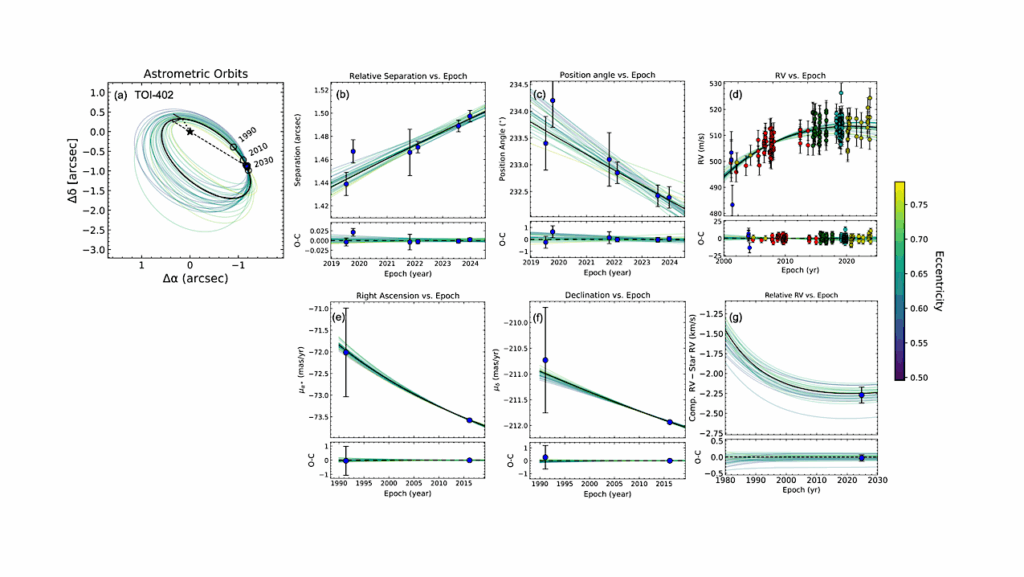An Extremely Low-density And Temperate Giant Exoplanet

Transiting extrasolar planets are key objects in the study of the formation, migration, and evolution of planetary systems. In particular, the exploration of the atmospheres of giant planets, through transmission spectroscopy or direct imaging, has revealed a large diversity in their chemical composition and physical properties.
Studying these giant planets allows one to test the global climate models that are used for the Earth and other solar system planets. However, these studies are mostly limited either to highly-irradiated transiting giant planets or directly-imaged giant planets at large separations. Here we report the physical characterisation of the planets in a bright multi-planetary system (HIP41378) in which the outer planet, HIP41378 f is a Saturn-sized planet (9.2 ± 0.1 R⊕) with an anomalously low density of 0.09 ± 0.02 g cm−3 that is not yet understood. Its equilibrium temperature is about 300 K.
Therefore, it represents a planet with a mild temperature, in between the hot Jupiters and the colder giant planets of the Solar System. It opens a new window for atmospheric characterisation of giant exoplanets with a moderate irradiation, with the next-generation space telescopes such as JWST and ARIEL as well as the extremely-large ground-based telescopes. HIP41378 f is thus an important laboratory to understand the effect of the irradiation on the physical properties and chemical composition of the atmosphere of planets.
A. Santerne, L. Malavolta, M. R. Kosiarek, F. Dai, C. D. Dressing, X. Dumusque, N. C. Hara, T. A. Lopez, A. Mortier, A. Vanderburg, V. Adibekyan, D. J. Armstrong, D. Barrado, S. C. C. Barros, D. Bayliss, D. Berardo, I. Boisse, A. S. Bonomo, F. Bouchy, D. J. A. Brown, L. A. Buchhave, R. P. Butler, A. Collier Cameron, R. Cosentino, J. D. Crane, I. J. M. Crossfield, M. Damasso, M. R. Deleuil, E. Delgado Mena, O. Demangeon, R. F. Díaz, J.-F. Donati, P. Figueira, B. J. Fulton, A. Ghedina, A. Harutyunyan, G. Hébrard, L. A. Hirsch, S. Hojjatpanah, A. W. Howard, H. Isaacson, D. W. Latham, J. Lillo-Box, M. López-Morales, C. Lovis, A. F. Martinez Fiorenzano, E. Molinari, O. Mousis, C. Moutou, C. Nava, L. D. Nielsen, H. P. Osborn, E. A. Petigura, D. F. Phillips, D. L. Pollacco, E. Poretti, K. Rice, N. C. Santos, D. Ségransan, S. A. Shectman, E. Sinukoff, S. G. Sousa, A. Sozzetti, J. K. Teske, S. Udry, A. Vigan, S. X. Wang, C. A. Watson, L. M. Weiss, P. J. Wheatley, J. N. Winn
(Submitted on 17 Nov 2019)
Comments: Preprint submitted to Nature Astronomy. The results have not been peer-reviewed yet. Supplementary informations available as ancillary file
Subjects: Earth and Planetary Astrophysics (astro-ph.EP)
Cite as: arXiv:1911.07355 [astro-ph.EP] (or arXiv:1911.07355v1 [astro-ph.EP] for this version)
Submission history
From: Alexandre Santerne
[v1] Sun, 17 Nov 2019 22:25:32 UTC (1,890 KB)
https://arxiv.org/abs/1911.07355
Astrobiology








